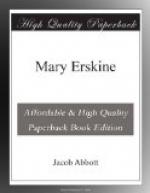“No,” said Mary Erskine. “I would rather come this fall.”
“Well,” rejoined Albert, speaking in a tone of great satisfaction. “Then I will get the house up next week, and we will be married very soon after.”
There were very few young men whose prospects in commencing life were so fair and favorable as those of Albert. In the first place, he was not obliged to incur any debt on account of his land, as most young farmers necessarily do. His land was one dollar an acre. He had one hundred dollars of his own, and enough besides to buy a winter stock of provisions for his house. He had expected to have gone in debt for the sixty dollars, the whole price of the land being one hundred and sixty; but to his great surprise and pleasure Mary Erskine told him, as they were coming home from seeing the land after the burn, that she had seventy-five dollars of her own, besides interest; and that she should like to have sixty dollars of that sum go toward paying for the land. The fifteen dollars that would be left, she said, would be enough to buy the furniture.
“I don’t think that will be quite enough,” said Albert.
“Yes,” said Mary Erskine. “We shall not want a great deal. We shall want a table and two chairs, and some things to cook with.”
“And a bed,” said Albert.
“Yes,” said Mary Erskine, “but I can make that myself. The cloth will not cost much, and you can get some straw for me. Next summer we can keep some geese, and so have a feather bed some day.”
“We shall want some knives and forks, and plates,” said Albert.
“Yes,” said Mary Erskine, “but they will not cost much. I think fifteen dollars will get us all we need. Besides there is more than fifteen dollars, for there is the interest.”
The money had been put out at interest in the village.
“Well,” said Albert, “and I can make the rest of the furniture that we shall need, this winter. I shall have a shop near the house. I have got the tools already.”
Thus all was arranged. Albert built his house on the spot which Mary Erskine thought would be the most pleasant for it, the week after her visit to the land. Three young men from the neighborhood assisted him, as is usual in such cases, on the understanding that Albert was to help each of them as many days about their work as they worked for him. This plan is often adopted by farmers in doing work which absolutely requires several men at a time, as for example, the raising of heavy logs one upon another to form the walls of a house. In order to obtain logs for the building Albert and his helpers cut down fresh trees from the forest, as the blackened and half-burned trunks, which lay about his clearing, were of course unsuitable for such a work. They selected the tallest and straightest trees, and after felling them and cutting them to the proper length, they hauled them to the spot by means of oxen. The ground served for a floor, and the fire-place was made of stones. The roof was formed of sheets of hemlock bark, laid, like slates upon rafters made of the stems of slender trees. Albert promised Mary Erskine that, as soon as the snow came, in the winter, to make a road, so that he could get through the woods with a load of boards upon a sled, he would make her a floor.




